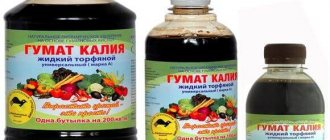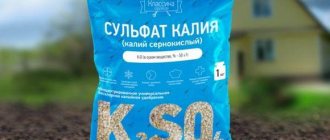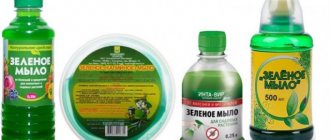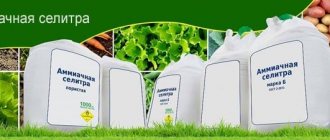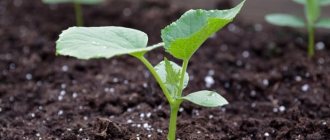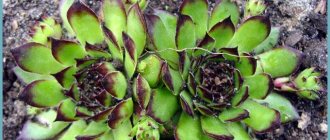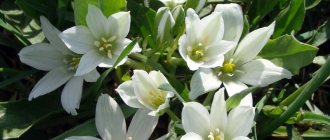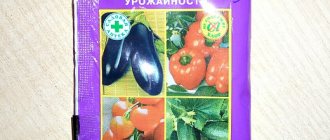Potassium monophosphate: features of mineral compounds
Potassium monophosphate (MPP) is a ballast-free fertilizer based on a high-percentage potassium-phosphorus concentrate, used to feed plantings. Has the following characteristics:
- chemical formula – KH2PO4 (dihydrogen orthophosphate);
- single crystal density – 2.34 g/cm3;
- water solubility: readily soluble;
- the composition includes the following components: phosphorus – 50–52%; potassium – 33–34%;
Potassium monophosphate (MPP) is a ballast-free fertilizer based on high-percentage potassium-phosphorus concentrate
- release form - 25 kg bag or 500 g plastic bag (sold in a gardening store);
- what they look like: granules or powder of white, beige, slightly brown color.
ATTENTION! Pronounced yellowness in color is evidence of unwanted impurities (defects).
When should you use monopotassium phosphate?
Potassium dihydrogen orthophosphate can be added at all stages of active growth, from growing seedlings to the period of flowering and fruit set.
Regular feeding allows you to:
- improve the quality of fruiting by extending the flowering period and increasing the number of ovaries;
- improve the organoleptic characteristics of fruits;
- increase crop resistance to return frosts, fungi, pests and diseases;
- increase the number of shoots and green mass on garden plants, garden trees and shrubs.
The use of this fertilizer will allow you to obtain viable planting material with a well-developed root system already at the stage of growing seedlings. The addition of potassium monophosphate allows you to obtain a large volume of green mass.
The requirements for phosphorus and potassium are determined by the stage of the plant’s growing season, and the effectiveness of the substance depends on the method of its application to the soil.
At the first stage of the growing season, when the plant’s first 4-8 leaves appear, root feeding is required. To prepare a nutrient solution, take 10 g of fertilizer per 10 liters of water. For 1 m² you will need 5 liters of ready-made solution. Such fertilizing should be carried out at the very beginning of spring during the period of growing seedlings. At the same time, indoor crops are fed; they are just beginning to emerge from the winter dormant period.
The next feeding should be carried out after transplanting the seedlings into open ground and after the germination of vegetable crops sown with seeds in the beds. At this stage, feeding should be foliar. The prepared solution, for which 20 g of monophosphate is taken per 10 liters of water, is sprinkled. The spray is sprayed at the rate of: 3 liters of prepared solution per 1 m².
Then you need to fertilize at the stage of bud formation. The same solution that is used for sprinkling, newly prepared, is consumed taking into account the growing needs of plants for potassium. For 1 m², 6 liters are already required. The concentration of the solution used should be 0.3%. For berry bushes, 10 liters per 1 m² will be required to irrigate the crown. For garden trees, one trunk requires up to 25 liters of nutrient solution at the stage of bud formation and fruit set.
In general, to provide cultivated plants with the necessary amount of potassium and phosphorus, it will be necessary to carry out at least 10 fertilizing per season during one season, from the moment of growing seedlings to harvesting.
Features of the use of superphosphate fertilizers
The product is used for root nutrition or as foliar fertilizer for open and closed soils. Before watering, pre-moisten the soil.
Potassium monophosphate is effective:
- after picking, during transplanting seedlings;
- when feeding decorative plantings during the flowering period, fruit plants - after flowering;
- against powdery mildew (grapes, apples, cucumbers, roses);
- as a component of complex mixtures;
- on medium and small areas with manual processing.
Features of feeding grapes
Grapes need magnesium most of all, so plantings in late summer and early autumn are fed with potassium magnesia, which has a rather low activity. It is slowly transported in plant tissues and is also absorbed. Therefore, if the summer is warm and long, the vineyard will have time to saturate itself with potassium and gain strength. If the weather was cool and humid, it is recommended to use potassium monophosphate as an active pre-winter preparation. Then, thanks to the high activity of the fertilizer, the vines will be able to overwinter without problems and produce a good harvest next season.
Advantages of potassium monophosphate
The fertilizer is often used for flowers (flower beds and indoors), vegetables, berries, fruits, because it has many advantages:
- Increases the quantity and quality (sugar content, usefulness, safety) of fruit crops.
- Accelerates the onset of flowering of ornamental seedlings, increases its abundance and duration.
Potassium monophosphate accelerates the onset of flowering of ornamental seedlings
- Protects against fungus (eliminates powdery mildew).
- Promotes the formation of shoots and an increase in their number.
- Increases frost resistance of trees and bushes.
- Chemically pure compound. Does not contain chlorine, sodium, metals. The product does not cause burns to greenery.
- It dissolves in water practically without sediment, hence the high degree and rapid process of assimilation by plants.
- Non-hygroscopic, non-caking.
- It is compatible with almost every pesticide or bait, so it is often used when preparing various nutritional mixtures.
- Moisturizes dry greenhouse soil, allowing you to reduce water consumption in the greenhouse.
- Overfeeding them is almost impossible.
- There are no side effects.
- Does not change soil acidity.
- The high activity of the drug makes it possible to re-feed with nitrogen after waiting from two to five days.
According to consumer reviews, monopotassium phosphate is a very effective remedy.
Stepan, 56 years old:
“I have been using monopotassium phosphate for several years now, growing various crops on the plot with my wife. In the spring, when we plant plants, we fertilize them - in the fall we have as many vegetables as we have never seen before. There are enough reserves for the whole winter. I recommend it to others!”
Fertilizer Potassium Monophosphate
Vasilisa, 35 years old:
“I have been feeding my indoor plants with potassium monophosphate for several years now. Flowers delight the eye with their health, do not get sick, bloom for a long time and are very lush. I like the result."
Expert opinion on potassium monophosphate
Potassium monophosphate is a salt that dissolves over one season. Suitable for feeding all crops during budding and flowering, ovary formation, and when growing vegetable seedlings. Due to its complete, rapid solubility, it is suitable for drip irrigation. Used as an independent fertilizer, in combination with other fertilizers, except magnesium and calcium.
Anatoly Baykov
Properties
Potassium monophosphate is highly soluble in water. When fertilizing the soil, phosphorus is absorbed by 23%, potassium by 28%. Phosphorus takes part in vegetation and photosynthesis. Its deficiency negatively affects:
- height;
- bloom;
- fruit formation.
If there is enough of it in the soil, then the plant gains mass faster, more flowers and ovaries are formed, and the leaves become greener. The root system will become more branched in a short time.
Potassium is necessary for water-salt metabolism. The use of potassium monophosphate helps to increase the overall immunity of plants.
With a lack of potassium, fruits quickly become lethargic and are poorly stored. It is not necessary to use it together with calcium and magnesium salts, since the effectiveness of fertilizing is reduced.
It is recommended to prepare the powdered form in boiled or distilled water. The granular preparation can be dissolved even in well, simple tap and spring water. Good solubility contributes to good absorption of fertilizer by the plant. Thanks to this fertilizer, crops become more resistant to minor return frosts.
Disadvantages of the product
Of course, there are no ideal drugs. The disadvantages of potassium monophosphate are:
- Quite a high cost.
- It is strongly recommended not to mix the product with magnesium and calcium preparations, which limits its suitability for a number of crops.
- The plant will accept the components of the drug well only in the presence of nitrogen, but it is not recommended to combine monopotassium phosphate with nitrogen mixtures at the same time.
- The active substances of the drug do not accumulate in the soil and quickly disintegrate, so feeding is carried out mainly with solutions. Applying dry fertilizer to the soil does not harm the crops, but it does not provide any benefit either. Therefore, it is almost unsuitable for pre-winter feeding of vegetation.
- Potassium monophosphate is recommended for use in warm seasons in the absence of heat and moderate humidity. In a greenhouse - with regular ventilation and good lighting.
- It has the same effect on weeds as on cultivated vegetation. Use it if you carefully weed your plantings. Untidy summer cottages risk turning into weed jungles.
- The solution is very unstable in air. Use it immediately after preparation.
- May cause excessive tillering (short cuttings), so limit it for flowers grown for bouquets.
- Being a highly active drug, it is unacceptable for potted flowers that develop slowly (succulents, orchids, azaleas, gloxinias, cyclamens).
- It is not the most concentrated potassium-phosphorus fertilizer. Potassium nitrate is superior to it in the first component, superphosphates - in the second.
It has the same effect on weeds as on cultivated vegetation.
There are negative reviews about this product:
Vasily, 55 years old:
I once saw a plot where weeds grew about two meters high. They say that they grow at the expense of the vegetables they are in the neighborhood with. But the owners of the garden bed said that the problem was due to excessive fertilization with potassium monophosphate. It's called "overdoing it"!
Advantages and disadvantages
Phosphorus-potassium fertilizing is well accepted and absorbed by all parts of plants, that is, not only by the root system, but also by stems and foliage. It does not include chlorine and is completely safe for nature and humans, unless added randomly and in large quantities.
There are other advantages:
- fertilizing activates the growth of full-fledged side shoots;
- increases immunity to powdery mildew and other pests, as well as diseases;
- improves sensitivity to temperature changes, especially frost, as well as changes in air humidity;
- promotes long and active flowering of ornamental crops and indoor flowers;
- activates root formation in seedlings;
- helps retain moisture in the soil in greenhouses, which is important during the dry season;
- reduces the fall of ovaries, increases their quantity and quality;
- activates the absorption of vitamins and carbohydrates, which has a beneficial effect on the taste of the fruit.
Agricultural technologists and agronomists also talk about the disadvantages of monopotassium phosphate:
- stops the growth of cuttings of roses and other flowers that are cut for bouquets;
- slows down the growth of ornamental plants that themselves develop slowly, for example, succulents, orchids;
- not compatible with potash and magnesium fertilizers;
- suitable only for one-time processing, since the constituent elements are destroyed under the influence of air and sunlight;
- quickly washed out after prolonged rains and active frequent watering, so regular application is required, since plantings react acutely to a lack of potassium;
- activates the growth of not only vegetables, trees, bushes, but also weeds.
After being added to the soil, potassium monophosphate crystals immediately disintegrate; it is better to dissolve them in water. They are not suitable for autumn preparation of soil for wintering. Capricious and demanding of the environment. For their positive effect, humidity should be moderate and temperature not high.
During storage of potassium monophosphate, the granules should not be allowed to get wet so that they do not dissolve and lose their beneficial properties. Experts advise purchasing this fertilizer in small packages intended for single application.
Indications for use of fertilizer
The method of application may vary. Let's look at the most popular methods of use.
Watering.
The dosage is 0.1–0.15% (15–20 g of powder per 10 liters of water). Consumption rates for this solution:
- in the first stages of growth of vegetables and ornamental vegetation, 3–5 liters per square meter are consumed. m., and when they have three or four leaves - from five to ten liters;
- fruit trees, bushes - 10–20 liters per sq. m. (concentration can be increased to 30 g);
- greens (parsley, dill, celery) – 2–3 liters per 1 sq. m.
Spraying.
The procedure should be carried out in the evening so that the fertilizer is better absorbed without evaporating under the sun. For ornamental crops, spraying is carried out after a rainstorm. For planned foliar fertilization, the concentration of the solution is 2 g per 10 liters of water.
The procedure is carried out with small sprays until a wet surface film appears on the leaves. Avoid the formation of dripping drops.
Be sure to read the instructions for use inside the package.
Spraying plants
The product is used as a spray:
- under favorable weather conditions;
- for all garden crops;
- for better flowering of decorative flowers;
- for emergency feeding during potassium starvation.
Fertilizer analogues
In the absence of monopotassium phosphate, it can be replaced with other mineral fertilizers that have a similar effect on vegetable, garden and ornamental crops.
How can I replace potassium monophosphate?:
- Potassium nitrate is an excellent source of nitrogen and potassium, strengthens the immune system of plants and improves the taste of fruits.
- Superphosphate – contains a combination of phosphorus and nitrogen. Improves the growth of the green part of crops and strengthens the root system.
- Wood ash is a natural fertilizer that contains potassium. Its concentration depends on the type of initial wood raw material.
Potassium monophosphate is a highly effective fertilizer for vegetable, garden and ornamental crops. This feeding has a complex effect. It stimulates plant growth, strengthens the immune system and the root system. Protects against many diseases and increases productivity.
Seedlings, garden and vegetable garden
Let's consider the procedure for applying monopotassium phosphate for various crops.
Consumption rates for primary treatment:
- seedlings of vegetables and flowers - when 2-3 leaves are formed (7-10 g per 10 liters of water);
- vegetables at the beginning of fruiting, when tubers and root vegetables are formed - 7.5–15 g per 10 liters of water);
- fruit and berry trees, ornamental trees, shrubs - after flowering, 10–15 g per bucket of water.
Repeated treatment is carried out with the product in the same dosage. But for seedlings of vegetables and flowers, the event should be carried out two weeks after picking.
Although errors in the concentration of the feed are not serious, the correct dose will give maximum results.
Treatment of tomato seedlings with monopotassium phosphate
Instructions for treating individual plants with monopotassium phosphate:
For tomatoes.
Water the crop 2 times per season with an interval of 2 (3 in a good year) weeks. The concentration of the working solution is 0.15%. Consumption – a bucket for four bushes. In the intervals between scheduled watering of tomatoes, it is recommended to spray the leaves with a 0.02% solution.
Processing cucumbers.
Water the cucumbers on a schedule similar to the previous one. Use spraying, but correlate foliar feeding with the development of cucumbers (an alarming signal is a curved or pear-shaped fruit). If the shape of the cucumbers is not pleasing, and there is a week left before watering, then it is better to carry out a foliar procedure. In this case, postpone the next feeding, keeping an interval of 1.5–2 weeks.
Root vegetables, onions and garlic.
Feed potatoes only by treating the leaves so as not to harm the tubers. The rate of potassium monophosphate is from 0.02 to 0.05%, the number of applications is twice in one season. Bulb crops and other root crops are fed in the same way.
Feeding fruit and berry plants.
Fruit-bearing trees, bushes, and berries are cared for by watering. The concentration of the solution is 0.2%. You can water in the morning if there is no fog or rain and the soil is not dry. Unscheduled treatments on the crown should be carried out in productive years and after heavy rains. Only the green parts are sprayed (most of the solution is sprayed on the underside of the leaves).
Fertilizing strawberries with fertilizer
Chemical composition and operating principle of the fertilizer
In the agricultural sector, there are more than a hundred drugs that are offered as restorative therapy. But the right agrochemical is selected according to different parameters. Someone needs something strong and inexpensive. And for some, the main indicator is fast cooking.
Monopotassium salt or monopotassium phosphate (potassium dihydrogen phosphate) is a rapidly soluble substance. The compound is classified as crystalline. The crystals are colorless. They are shaped like pyramids.
But for agricultural work, monopotassium has changed the formula slightly. Because of which the color and shape have changed. Packages containing powder or granular substances are available for sale. Color range: from white to light brown.
The working solution is prepared quite simply: diluting the required dosage in liquid. The fertilizer contains two main components: potassium and phosphorus. The components are absorbed literally immediately after application.
Percentage:
- phosphorus – 23%;
- potassium – 25-28%.
Properties may change due to improper dilution or long-term storage of the prepared liquid. In this case, it is necessary to take into account exactly what form of potassium monophosphate the farmer purchased.
If a powder form is used, then it is diluted exclusively in distilled water. As a last resort, boil it. When purchasing a granular substance, dilution is permitted in other waters.
The instability of the substance to the external environment is considered a positive and at the same time negative point. Therefore, it is possible to overdose or inhibit the plant by only 5%.
Important! Monophosphate combines well with most crop feeding substances. This may be due to the neutral acidity of the monopotassium salt. This positive point indicates that after treatment with salt, the plant will not get burned.
Monopotassium phosphate and flowers
Fertilizer for flowers is used when the buds begin to bloom or if they have fully blossomed. If the year is favorable, water the seedlings with a solution at a concentration of 0.1%, the consumption rate is 3–4 l/sq.m. m.
Having noticed 3-4 formed leaves on the flowers, so that flowering occurs earlier, spray with a solution of 0.02%.
Outdoor flowerpots and hanging flowers are fed in the same way as ground plantings.
Potassium monophosphate is suitable for most flowering plants: petunias, tulips, phlox, roses.
Signs of nutritional deficiencies
Mineral deficiency can always be determined by the appearance of plants:
- The root system is extremely poorly developed.
- The development of the bush is sluggish and generally unnoticeable.
- The shoots lose turgor, the foliage becomes covered with dark brown spots and has a reddish-rusty tan along the edges (lack of potassium), or acquires a burgundy-purple hue (lack of phosphorus).
- The budding phase is delayed, few flowers are formed, against the background of an increased number of barren flowers.
- The yield of garden crops has been noticeably reduced, and the quality of the fruit does not meet the standard.
- Plants often get sick and are susceptible to attacks from pests; due to reduced immunity, perennial crops do not tolerate winter well and do not tolerate cold and frost.
At the same time, all types of crops experience a lack of minerals and the introduction of preparations that restore the balance is necessary for each variety:
- Garlic and onions require constant phosphorus-potassium fertilizing with breaks every 14...21 days, while the extreme procedure is provided three weeks before harvesting the turnips.
- Cucumbers, zucchini, cabbage - need fertilizer cyclically (up to four times per season).
- Tomatoes, eggplants, peppers, as well as grapevines - require up to 4...5 applications during the growing season (depending on age and condition). On average, feeding is provided: in the spring during the period of planting seedlings or at the stage of foliage development, then before flowering for 1...1.5 weeks, two weeks after it (during the formation of the ovaries), and during the ripening period.
- Strawberries are fertilized twice per season (before flowering and during the period of ovary development), selecting a product with a maximum level of potassium and a lower content of phosphorus.
- Fruit trees - the soil is fertilized at the time of planting seedlings, then in spring and autumn using the root method, and also during the season by spraying the crown.
In what cases is it used?
Monopotassium is considered an effective fertilizer. The main advantages of the product include the following:
- absence of harmful components and heavy metals in the composition;
- improving the taste of fruits;
- protection of plants from fungal microorganisms and powdery mildew;
- protection of seedlings from temperature fluctuations;
- maintaining optimal humidity parameters in the greenhouse;
- increasing the flowering period of domestic flowers;
- no risk of soil acidification.
The substance makes seedlings more resistant to adverse weather conditions and provides protection against pathologies and parasites. The drug is available in the form of powder or granules. Thanks to this, it is quickly absorbed by the soil and absorbed by plant roots.
The drug combines well with pesticides. Thanks to this, it allows for complex processing of crops in open ground. Experts recommend combining pesticides with fertilizer in one container.
See also
Instructions for using microbiological fertilizer for plants SiyanieRead
Fertilizer also has a good effect on soil microorganisms. By creating comfortable conditions, it is possible to more actively structure the soil. This is especially important for greenhouse soil, which often dries out. The use of the substance helps reduce the need for irrigation.
Precautionary measures
Caution is required when using monopotassium phosphate. It is recommended to store it in an airtight container. When spraying, you must take care of personal protective equipment for your hands and breathing. All work must be carried out wearing gloves, safety glasses and a respirator.
Access to chemicals by children under 14 years of age should be limited. If the drug gets inside the body, you need to urgently rinse the stomach, and if necessary, consult a doctor.
The harmlessness of potassium monophosphate for plants does not mean it is safe for humans.
Methods and frequency of use
Potassium monophosphate is used for root feeding and leaf spraying.
If fertilizer is added to the substrate (soil) for orchids, prepare a working solution based on:
- 1 g per 1 liter of water.
This feeding replaces regular watering.
Feeding is applied following the following recommendations:
- The orchid is fed for the first time as soon as it comes out of dormancy and a peduncle with buds appears.
- A repeat session is carried out at the beginning of the buds blooming.
- Another nutrient watering is planned at the height of flowering.
Potassium monophosphate should not be used when the plant is dormant or has been infected with fungal or bacterial diseases. Because pathogenic microorganisms are activated in the presence of phosphorus and potassium. The elements contribute to the rapid development and growth of pathogens.
It is better to use fertilizer as a preventive protective agent . For this purpose, fertilizing is used for foliar spraying .
For this purpose, prepare a solution whose concentration is 3 times less than for root watering.
This means that 1 g of fertilizer must be diluted in three liters of water. To apply the solution to the leaves, use a sprayer with a fine nozzle. The liquid flow rate is determined until a stable cover is formed on the plates. The fertilizer should not be allowed to collect in large drops and flow down. In this case, processing will be ineffective. Moreover, the active substance evaporates quickly, so it is important to retain it using uniform spraying.

